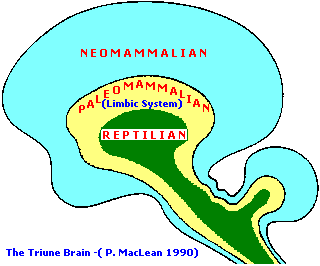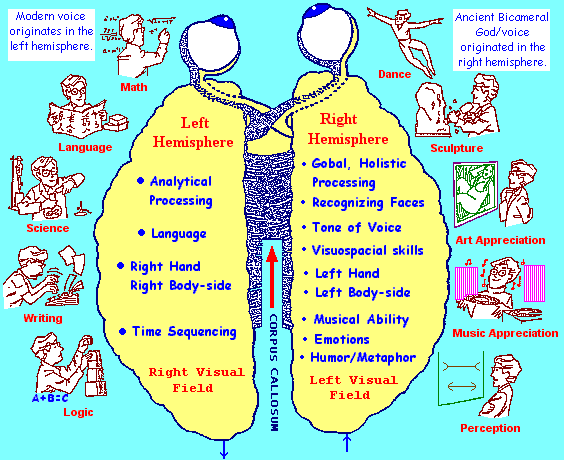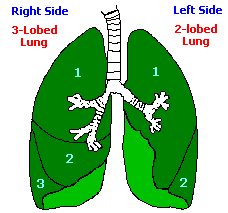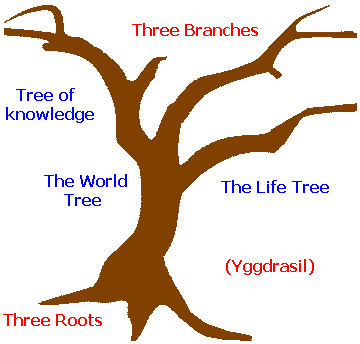(The Study of Threes)
http://threesology.org
Simply stated, Paul MacLean's triune brain hypothesis distinguishes that the human brain is 3 brains in 1:

To enhance our appreciation of brain development with respect to categorizing attributes that may help us to better distinguish between a criminal and non-criminal brain, we need to elaborate on a means to help us in differentiating characteristic related to these 3 different brain sections:
Attributes of the brain hemispheres show a distinctive (but somewhat overlapping) partitioning along a 1-patterned, 2-patterned, 3-patterned formula, with the earlier brain structures exhibiting a smaller numerically identifiable value, just as we find in the development of Primordial Germ Layers to the extent that we humans, as a complex organism, grow from 3 Germ Layers, and less complex organisms grow from fewer than 3 layers. This topic is discussed further in the Brain Attributes page.

***Note: Much of the brain illustration shown above was adapted from page 106 of Dean Falk's book entitled "Brain Dance," 1992.
When we look at the assigned culturally recognized attributes of the brain, we can see a distinct (over-lapping) 1-patterned, or 2-patterned, or 3-patterned arrangement:
| Left Hemisphere (Predominantly 3-patterned) Math: Associative Commutative Distributive Logic: Major Premise Minor Premise Conclusion Time Sequencing: Seconds~Minutes~Hours Past~ Present~Future Day~Week~Month Language: Subject Object Verb Right Body Side: Tri-cuspid heart valve Three-lobed lung |
Right
Hemisphere (Predominantly 2-patterned) Holistic: Macro versus Micro Whole versus Part Inner versus Outer Music: Major Scale vs Minor Scale Loud versus Soft (Quiet) Consonance vs Dissonance Visuospatial: (Art) Background vs Foreground Light vs Dark (Contrasts) 1 Dimension vs 2 Dimensions Emotions: Pain versus Pleasure Positive vs Negative Love versus Hate Left Body Side: Bi-cuspid heart valve Two-lobed lung |
 The correlations of two and three being made on this page are not typical considerations. However, I did come across a single reference concerning the
tricuspid valve: | |
 In recognizing that the left lung is smaller than the right lung (which provides room for the heart), let us conjecture that this is due to some past earlier developmental sequence just as we find the 1-layer, 2-layer, 3-layer sequential development of the 3 primordial germ layers (Ectoderm- Mesoderm- Endoderm) in primitive to more complex organisms. Hence, difference in size (dimorphism) as well as a two/ or three prominence may provide another link towards understanding developmental processes. Does this mean that the recurring smallness of the female to the male in many species indicates that females came before the male in terms of species-specific evolutionary development during particular environmental circumstances? If so, will there be an increased development towards a 3 to 1 "fusion" ratio? | |
In ancient times, it was once thought that a male child was generated from the right testicle and a female child from the left testicle. This right side = male and left side = female is in keeping with the cross-referencing pattern related to brain hemisphere functioning controlling the opposite side of the body, as seen when a person has a stroke. | |
|
(Reptilian) (Predominantly 1-Patterned) (Self)-Preservation~ (Self)-Procreation~ (Self)-Preeminence | |
Some additional two-patterned references found in music:
- Tension and Release
- Staccato and Legato
- Slow and Fast
- Ascending and Descending
An analogy to the above 3 divisions (Reptilian~ Mammalian~ Neo(New)-Mammalian) can
be made with the ancient view of the world once held by Nordic peoples who
thought the three roots and three limbs of the Yggdrasil tree held Earth, Hell,
and Heaven together. In their own way, they were illustrating a
fundamental organizational structure of the brain that matures along a 1~ 2~ 3
maturational development sequence. It is because of this underlying basic
formula that humans tend to organize world views in a three-patterned manner, in
singular and multiple representations thereof.
For those of you who have
a penchant for taking the obvious for granted, please note that the Nordic
peoples are part of the Indo-European family, and it is this (3rd born) family,
more so than (2nd born) Asians and (1st born) Africans which has the greatest
proclivity for developing three-patterned views of the world:

| Note: When we use the left hemisphere attribute
"analysis" to define qualities of the right hemisphere, we often-times
assign an additional third criteria in one form or another. When we
use the right hemisphere attribute 'viewing' (recognizing) to define
qualities of the left hemisphere, we often-times alter the 3-part
descriptions into 2-part 'portraits'. For example, (generally
speaking): Left "analyzing" Right: Holistic may acquire the additional term "Synergy" or "Unity"; Music can develop a Triadic structure; Art acquires a 3rd dimension and 3-color (trichromatic) theory; Emotion is assigned words such as Compassion, Patience, and Empathy. Right "viewing" Left: Math may be seen as Give & Take; Logic may become a Mind/Body dichotomy; Time is related to Life & Death; Language is perceived as High & Low pitch. Left "analyzing" Reptilian attributes may develop three criteria which distinguish a (3 in 1) singular nature, such as arousal, motivation, and emotion. Right "viewing" Reptilian attributes may picture the basic drives as the seat of emotion whereby a type of kinship alliance is formulated in order to maintain the idea of a dual brain by not permitting the "Reptilian Brain" a separate entity status. |
In adding to the above, we could include the
following remarks (taken out of their original context because they are related
to the present discussion):
"To further complicate the process, it has
been suggested that we have 3 major components in our brain function - instinct,
emotion, and intellect. The 3 layers of function correspond to the major
layers of brain matter that have been added as we evolved through various
stages. Evolution didn't throw much away as humans evolved - our brains
have added new layers on top of what was already there instead of the more
difficult total restructuring or replacement. We still harbor a primitive
reptilian brain at our cores that runs a lot of our subconscious systems like
digestion, respiration and circulation. Along the way we picked up a
number of only marginally compatible and integrated layers, evolving our
conscious minds only with the addition of the outermost layer."
by Kort E Patterson
Herb O. Buckland
herbobuckland@hotmail.com
Date of Origin: Monday, January 14, 2013, 6:26:18 AM
Update: Monday, March 8th, 2021... 2:04 PM